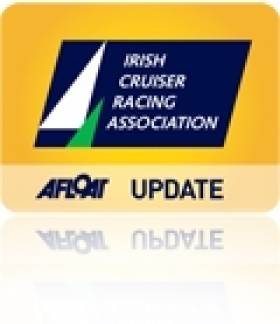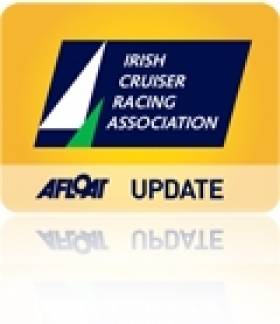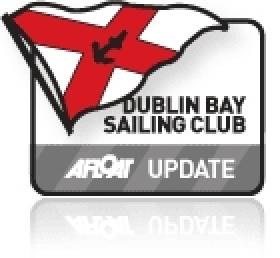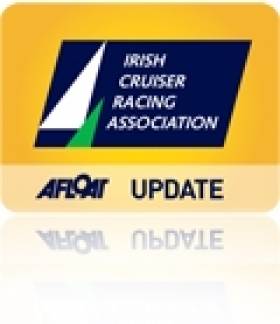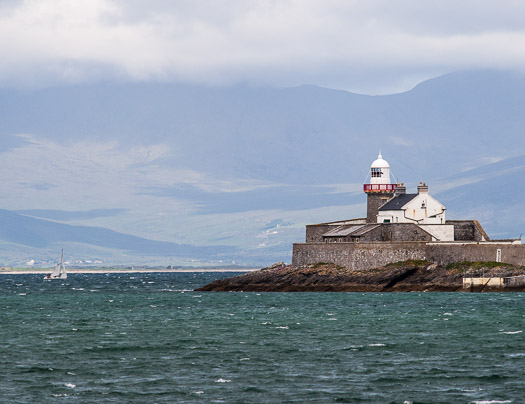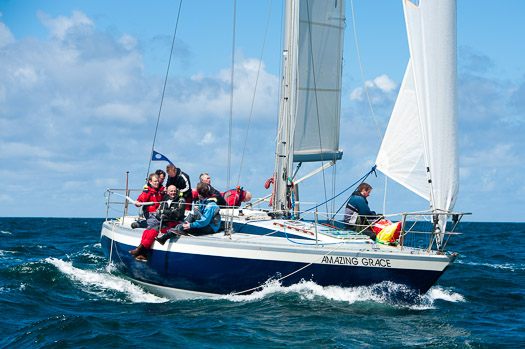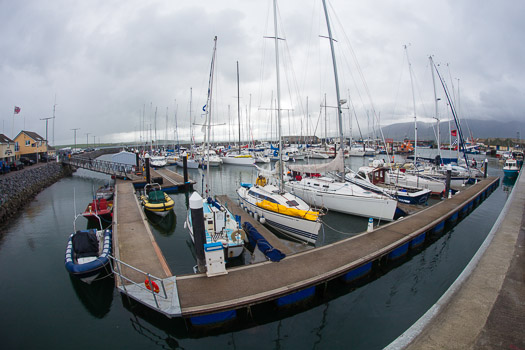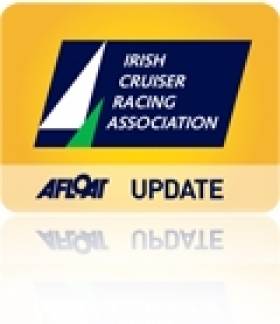#icra – The Irish Cruiser Racing Association has come through challenging times recently, but Commodore Nobby Reilly sees strengthening light at the end of the tunnel. W M Nixon takes a look at ICRA and its upcoming Annual Conference in four weeks time, and somehow concludes his piece with an earthy opinion on keel and rudder design from Ted Turner.
"When you're going backwards, it's hard to stop". Difficult to see where you're going, too. The speaker is Norbert 'Nobby' Reilly, currently serving his five year watch as Commodore of the Irish Cruiser Racing Association, which will hold its Annual Conference on Saturday November 23rd in the Royal Irish YC in Dun Laoghaire. At it, the ICRA Commodore is confident the attendance will share his very strongly held belief that going backwards is now history.
In its eleven short years of remarkable existence, ICRA has embodied the highs and lows of Irish life as we zoomed up to the dizzy heights of the Celtic Tiger years, and then fell off a cliff, plunging to reality after 2008.
When the going was good.....No. Let's re-phrase that. When the going was plain crazy, Irish sailing through ICRA was in the astonishing position of putting forward three teams for the biennial international Commodore's Cup.
To outsiders, it seemed absurd that those teams appeared to be racing against each other with even more venom than they were using against the international rivals. Where was the unwritten code of the green jersey? Not surprisingly, they didn't win the Cup itself, though one team was tantalizingly close. But not to worry, surely there'd be even more new boats and fresh paper millionaires along next time, we'd do better next time round.
Chance would be a fine thing. The writing was already engraved and not merely scribbled on the economic wall when just one Irish team, carefully put together by manager Barry Rose to harbour scarce resources, did finally win the Commodore's Cup in 2010.
It was a peak of achievement for Irish sailing, and despite the fact that ICRA is just basically four people – Barry Rose of Cork, Nobby Reilly of Howth, Fintan Cairns of Dun Laoghire, and number cruncher Denis Kiely of cyberspace – this virtual organization became the Mitsubishi Motors 'Sailing Club of the Year' for 2011, and a very popular choice it was too.
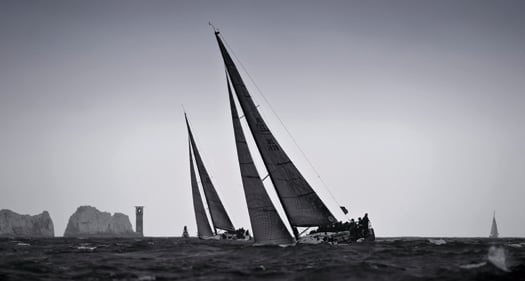
Anthony O'Leary's Ker 39 Antix from Cork was one of the team which finally won the Commodore's Cup for Ireland in 2010. Photo: Kurt Arrigo/Rolex
But by that time the ICRA people had gone back to the knitting, for they knew the prospects for sailing in general – and particularly for Ireland's international offshore racing campaigns – could well get worse before they got better. So though they lived in hope, they threw renewed energy into being the organisation which looks after the needs and hopes of handicap racers in Ireland. While simple enough to outline, it's a complex mission, and in addition to high awareness of international developments, it requires constant monitoring of the mood at grass roots level, for the strength of Irish offshore sailing is drawn from active local clubs all round the coast in addition to the inevitable focus on the big centres around Cork, Dublin and Belfast.
Thus when the blow fell and Barry Rose and his management team had to reluctantly conclude there'd be no prospect of a viable Irish team to defend the Commodore's Cup in 2012, at home the efforts were re-doubled in order to ensure that each year's annual ICRA National Championship was an event worthy of its title, and worthy of past championships. Then too, there was a determination to see that those clubs which had supported the Nationals by sending boats to other venues were in their turn rewarded by an invitation to host the Nationals themselves, with the implicit promise that this would bring fleets of top calibre to new places.
As well, there were visionary programmes to introduce newcomers to offshore racing using many different methods, including open days with the flotilla of the SailFleet J/80s. All this showed that ICRA was very much open for business. And all the time Denis Kiely was keeping the numbers up to date so that there were realistic figures available, giving ready reference for comparisons between IRC and ECHO handicap systems, for one of ICRA's strengths has been that it accommodates people who can't see their way to giving their boat the complete IRC treatment, but can afford to go the ECHO route.
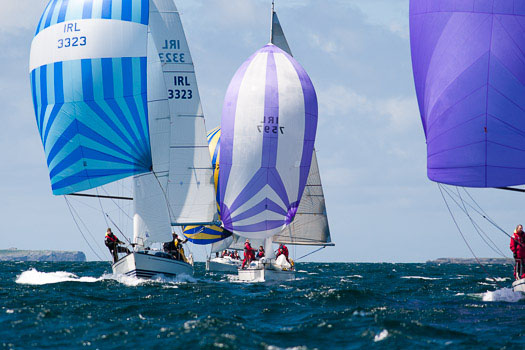
Racing at ICRA National Championship 2013 in Tralee Bay Photo: Bob Bateman
So it is that even with the constraints of Ireland's recent economic experience, ICRA has performed extremely well. Despite some unseasonal weather, the 2013 Nationals at Tralee Bay had some splendid racing, and attracted a fleet of a size and calibre rarely if ever seen beyond Mizen Head.
In addition, Irish boats have been turning in some good showings abroad in addition to the achievements by the top performers at home, and the voters for the coveted ICRA Boat of the Year 2013 award – currently held by the Galway Bay SC Reflex 38 Lynx – have a bewildering array to choose from, as boats which took the prizes at events as diverse as the ICRA Nationals at Tralee and the Sovereigns Cup at Kinsale are joined by those who had success in the Volvo Dun Laoghaire Regatta in Dublin Bay, the top performer there being Nigel Biggs' Checkmate XV which went on to win the World Half Ton Classics.
Then there was the Tralee Bay veteran boat Amazing Grace's victory in the Dun Laoghaire-Dingle Race - as somebody said, she's not called 'Amazing' for nothing – while Lynx as 'Discover Ireland' was well placed in the Fastnet and comfortably tops of all the Irish boats to win the Gull Salver, though we'll resist the temptation to point out that discovering one small but significant part of Ireland is surely what the Fastnet Race is all about.
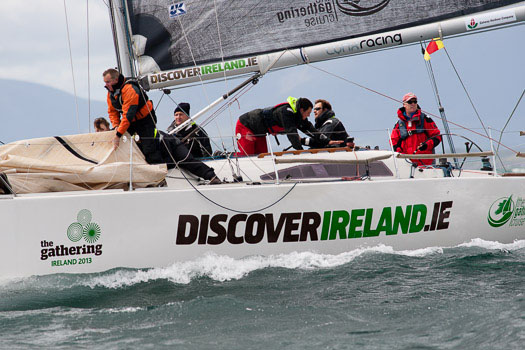
Discover Ireland took the prize in the Fastnet Race. Photo: Bob Bateman
All this is before the more recent rush of achievement, with David Kenefick of Cork with his Figaro Solo boat Full Irish winning the Rookie of the Year award, while there's been the Irish success in crewing in the Middle Sea Race, and Paul Winkelmann has brought good news from the Far East with his Class 1 victory in the China Sea Race.
On the administrative front, ICRA received an unsought but welcome boost when Mike Urwin, the head of the RORC's Measurement Office, reported that the Irish system of using ECHO and IRC handicap systems in cruiser-racer events is something which could usefully be learned from and emulated elsewhere. Maybe so, but anyone contemplating using the ECHO system should note that it works best when people race regularly and frequently, for it is a fact that in Ireland many cruisers which wouldn't be seen as racers at all elsewhere are keen to get onto the starting line, and ICRA makes sense out of what they do.
So Nobby Reilly's confident assertion that forward gear was firmly re-engaged in ICRA during 2013 is clearly borne out by even the most cursory review of the year. Looking ahead to 2014, the prospects are bright. Barry Rose already has the makings of a Commodore's Cup team with one Irish boat and an Irish-crewed American boat already signed up. With that strong foundation in place, it will be fascinating to see how the bids for the third place take shape.
As for the ICRA Nationals, it could well be the biggest yet seen, as it's scheduled for the Royal Irish YC from June 13th to 15th, which will reinforce ICRA's strong fraternal links with ISORA. For international contenders, it also offers the juicy attraction of being neatly located for the Round Ireland Race from Wicklow on Saturday June 24th, with the bonus of the Royal Irish being recognised as an official assembly point for Round Ireland Racers too large to use Wicklow Harbour for the pre-race scrutineering. And for those who'd like to spice their sailing with a spot of high culture, the day after the ICRA Nationals conclude, Monday June 16th is Bloomsday, with a special Royal Alfred YC sailing event which will honour the sailing connections in the writings of James Joyce, which is something we might just examine in detail another day.

The ICRA management team are always aware that they also have to consider the needs of keen boats and crews based far from the main sailing centres. This is the successful Dis-a-Ray on her home mooring at Tarbert in the Shannon Estuary. Photo W M Nixon
Meanwhile, though the ICRA focus will inevitably be on the east coast in 2014, the Association is well aware of its responsibilities to its fraternal organization, the West of Ireland Offshore Racing Association, which was much involved with 2013's main event in Tralee Bay. In 2014, the WIORA Championship will be at Mayo Sailing Club in Clew Bay from Wednesday 23rd to Saturday 26th July. It's a marvellous venue right on the doorstep of Westport, voted the "Best Place to Live in Ireland" in 2013. But it's so far from the main east coast centres that you're sailing for home whichever way you turn when coming out of Clew Bay. So Nobby Reilly is very keen that the ISA SailFleet J/80s should be taken to MSC's base at Rosmoney and made available for the WIORA Championships for junior crews selected and trained by yacht clubs from other coastlines, which is a brilliant notion.
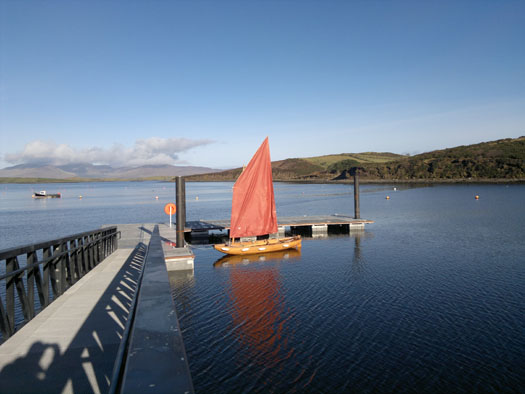
The WIORA Championship 2014 will be at the end of July 2014 at Mayo Sailing Club at Rosmoney in Clew Bay, where this new pontoon is a fine addition to facilities in a sailing area of outstanding beauty. Photo: Rory Casey
But the ICRA Annual Conference will also look beyond the needs of Irish sailing and the Commodore's Cup, as one of the main speaker attractions at the Conference on November 23rd will be Matt Sheahan. He may be the internationally-recognised Technical Editor of Yachting World, but he's one of us, as his folks cam from Dublin, and he also crewed betimes with his old mate Nobby Reilly on Comanche Raider, the big Rob Humphreys-designed offshore racer which was always one of the best-looking boats on the Irish Sea.
After the America's Cup excitement last month, it was Matt's cool on-the-spot analysis of the modifications which the Team Oracle USA people had made during the final series which most clearly brought home to readers just how tiny the game-changing mods could be, yet they helped the Americans come from far behind to retain the trophy.
A particular area of development was the fitting of tiny bulbs to the big catamaran's foils to reduce drag. We are all well aware that the fitting of bulbs under the bows of big ships must be worthwhile, as ship-owners – a notably parsimonious breed – will lash out on such things, confident that they make their vessels more easily driven and therefore more economical. Yet anyone who is accustomed to watching ship and boat hulls move through a seaway will guess that bulbs are at their most effective when there is minimal pitching, as a bulb going up and down, rather than just smoothly forward, will generate a whole new dimension of turbulence.
But the bigger the ship, the less the pitching, and the greater the benefit. When we remember that the America's Cup 72ft catamarans were sailing in what was for them smooth water, the fact that their hulls were not pitching, but rising relatively slowly on the foils, could be accommodated by the bulbs with a level of turbulence which was acceptable in view of the performance benefits shown a few second later. And once the benefit had been shown, the crucial thing then became just how far forward the bulb should be located relative to the foil – it seems an inch or so made a significant difference.
On ships, some bulbs are now remarkably long, with the total underbody being shaped to be as economical as possible in the prevailing conditions in which the ship will be functioning. What will work best averaged over a long period in narrow waters such as the North or English Channels may not necessarily work as well in open ocean, or indeed on wider waterways such as the Irish Sea or St George's Channel, but the Baltic area seems to create ships which work well in our channels.
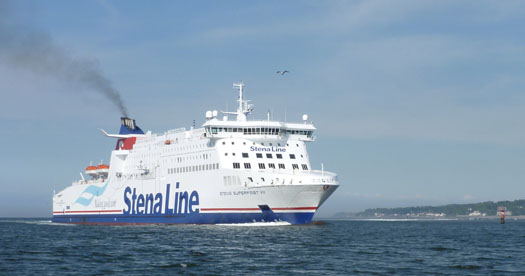
The extra large bulb under the bow of the Stena Superfast VII begins to become more evident as she slows down approaching Belfast. Note her quarter wave on the port side creating surf on the Holywood Bank. Photo; W M Nixon
We were making our way into Belfast early in the summer and one of the 30,000-ton Stena Superfast vessels coming in from Scotland overtook us. In open water, she'd been travelling from Cairnryan in Loch Ryan at 27 knots – which is cooking with gas – but even with a lot of slowing down approaching the head of the lough, she was a big waterborne presence, and we noted her wake breaking spectacularly on the Holywood Bank on her port quarter close astern.
But even more notable as she drew abeam was the bulb, at first immersed under an almost sinister little hill of water, but then revealed with its own bow-wave as the Stena Superfast VII slowed even further. The bulb seemed to be the size of a mini-submarine.
The ships of this marque were originally built for Baltic crossings in 2001 or thereabouts. Stena chartered two of them longterm two years ago, gave them a massive refit with new livery, and put them on the route serving their new £80 million terminal at Cairnryan. With a crossing time of just 2 hours and 15 minutes without the hassle of getting yourself all the way down to Larne for the shorter sea route, it looks as if big bulbs do the business.

The bulb is the size of a mini-submarine, yet it helps the Stena Superfast VII to travel economically at a very competitive 27 knots on the Belfast-Cairnryan route. Photo: W M Nixon
But as with anything to do with the sea, it all has to be a total package. With bulbs as with boat hulls, you have to think tadpole. A tadpole has a bullet head with a long tail which may primarily provide motive power, yet it takes very little effort to move a tadpole quickly and easily through the water. If it didn't, frogs would have long since become extinct. But it's a relatively straightforward business parting the waters, it's how they close in behind that decides whether tadpoles or boats or bulbs are easily driven.
Down in West Cork, one of our agents (who had better be anonymous this time round) came upon this hull modification near the banks of the Ilen River. Somebody in Skibbereen had clearly taken on board the value of bulbs on the bow, but hadn't quite seen the notion through to complete fulfillment of all requirements.
At first it seems a clever use of Camping Gaz containers, but closer examinaton reveals it is Blugas. Maybe it's only Blugas bottles can be utilized in this way, or maybe it was a cunning advertising ploy to publicise the lesser-known product. Whatever, it looks as though a clever idea hasn't been completely thought through – this Blugas bow bulb needs a tail. And lest you think that we're trying to get this Ilen innovator into fresh expense, Afloat.ie's R & D department reckons just one traffic cone and the cunning use of epoxy, with the new tail filled with builder's foam, is all that is needed.
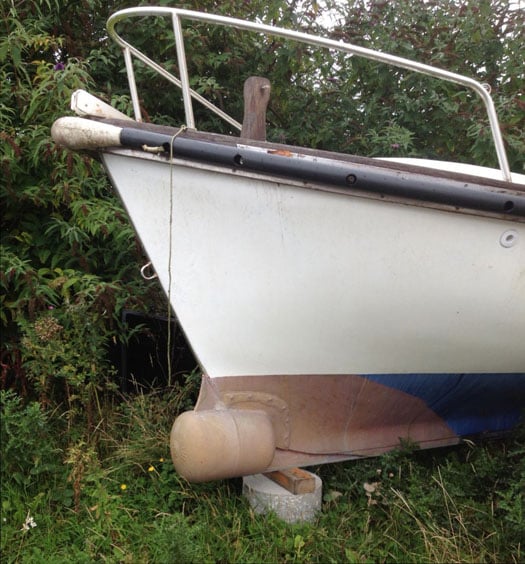
Lateral thinking, West Cork style. Former gas cylinders have been pressed into use to create a bow bulb........
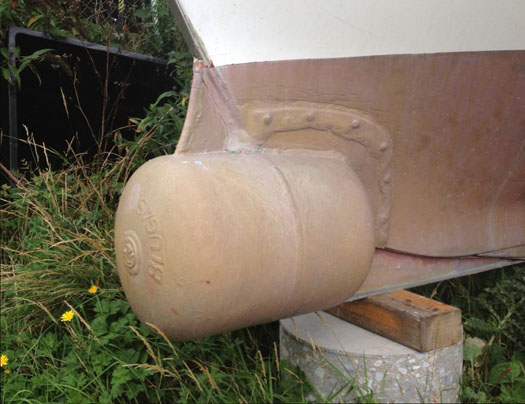
....but we'd suggest the additional use, at the aft end, of a modified traffic cone might produce an even more effective shape.
The final word on the need for a tadpole tail was delivered by the great Ted Turner many years ago, when he was called upon to see if he could get some sort of improved performance out of a new 12 Metre, an America's Cup potential defender designed by the late Britton Chance. In his plans, the perenially innovative designer had replaced the usual sharp trailing edges of keel and rudder with quite wide flat surfaces. He claimed that if these cut-off endings were of the right width, a width which he'd calculated himself down the zillionth degree, then the keel and rudder would create a vortex on their flat trailing surfaces such that the sea would be beguiled into thinking that they actually finished quite a few inches further aft, and finishing moreover in a sharp trailing edge in keeping with accepted practice. With the reduction in wetted surface brought by the cut-off look, light air performance would also be greatly enhanced.
Well, it wasn't, and nor was performance in airs of any kind. You can't fool the sea. So after giving it his best shot, Turner asked if he could see the boat out of the water, as his inability to resist a challenge had meant he'd taken it on sight unseen. So there was the boat still dripping, and the flat back ends all too obvious as Professor Chance launched into a spiel about how it all worked perfectly in theory, and so there must be some other reason for the boat's poor performance.
Turner let him have his say, then demolished the theory. "Britty" said he in his best good old boy style, "Britty, even a standard piece of floating faeces finishes in a point".
Except that the great man didn't use the cumbersome term "standard piece of floating faeces". He used a rough four letter word beginning with 'T'. But this website having a family readership, and it the Bank Holiday weekend too, we won't use the T-word this time round. Have a good weekend.





































